
2 min read
Designer's Guide to Green Certifications
A Primer for Healthy Homes and Interiors. Who is gatekeeping wellness and sustainable design? WLLW looks at green certifications in brief.

2 min read
WLLW takes a closer look at the green certification Cradle to Cradle which takes inspiration from the natural world, where there is no concept of waste.
Cradle to Cradle is a design principle and methodology developed by American architect William McDonough and German chemist Michael Braungart – with the original concept credited to Swiss architect Walter Stahel in his 1976 vision for what would later become known as the circular economy.
McDonough and Braungart take their inspiration from the natural world where there is no concept of waste, with everything instead being a resource for something else. It describes circular design where products – made with raw materials that are safe, non-toxic and biodegradable – are never thrown away and are reused indefinitely. They are treated like nutrients, as ‘food’ for new products with each element serving as either a ‘technical nutrient’ reused as a high quality material without contamination or returned safely back to the earth as a ‘biological nutrient’.
The principles of Cradle to Cradle celebrate diversity and support human and environmental health while promoting the use of clean, renewable energy, such as solar, wind and geothermal, while once again taking inspiration from the natural world where living things thrive on solar energy. Their concept reframes design as positive – overcoming challenges, seeking opportunities and spurring innovation.

A gamet including textiles, apparel, footwear, beauty, building materials, outdoor furniture, packaging, paint, cleaning supplies, craft materials.
C2C evaluates items across five sustainability categories – material health, product circularity, clean air and climate protection, social fairness and water and soil stewardship – to ensure they are safe, circular, and responsibly made.

In order to qualify for C2C certification companies must ensure through a third party that they meet the current version of the C2C standard which takes into account scores in each of the aforementioned categories. The latest version of this standard went into effect on July 1, 2021. It includes more rigorous requirements needed to address climate change and expanded the requirements for water and soil health. In this way, the guidelines are open to change, evolving with the changing needs of the planet. Qualifying for C2C certification also means avoiding materials on a Restricted Substances List. This list is a register of the chemicals that, when above certain thresholds, have been found to be harmful or toxic to the environment and human health.


Environmental sustainability: C2C design encourages the use of renewable resources, minimizes waste, and reduces the environmental impact of products.
Positive impact on human health: C2C design requires the elimination of harmful substances from products, which can improve indoor air quality and promote better health.
Circular economy: C2C design encourages the creation of closed-loop systems, where waste from one product becomes the raw material for another, reducing the need for virgin materials and promoting a circular economy.
Complexity: C2C design requires careful consideration of the entire life cycle of a product, which can make it more complex and time-consuming to design and manufacture products.
Cost: C2C design can sometimes require the use of more expensive materials or production processes, which can increase the cost of products.
Limited availability: C2C certified products are not yet widely available, which can limit the options for consumers and businesses looking to make sustainable choices.
Certification process: C2C certification requires a rigorous evaluation process, which can be challenging and time-consuming for manufacturers.
Photography: Appolinary Kalashnikova/Unsplash, Bang & Olufsen, Andreu World
Image courtesy of MBDC via William McDonough

2 min read
A Primer for Healthy Homes and Interiors. Who is gatekeeping wellness and sustainable design? WLLW looks at green certifications in brief.

4 min read
The book ‘Material Health: Design Frontiers’ from Parsons Healthy Materials Lab explores the critical topics of material health in the era of climate crisis.